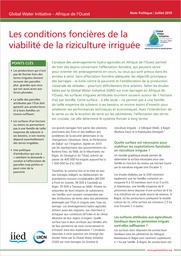Les conditions foncières de la viabilité de la riziculture irriguée
L’analyse des aménagements hydro-agricoles en Afrique de l’Ouest permet de tirer des leçons concernant l’affectation foncière, qui peuvent servir pour orienter les aménagements en cours, ou ceux qui sont prévus dans les années à venir. Sans affectation foncière adéquate, les objectifs principaux des barrages – la lutte contre la pauvreté et l’amélioration de la production nationale de céréales – pourront difficilement être atteints.


